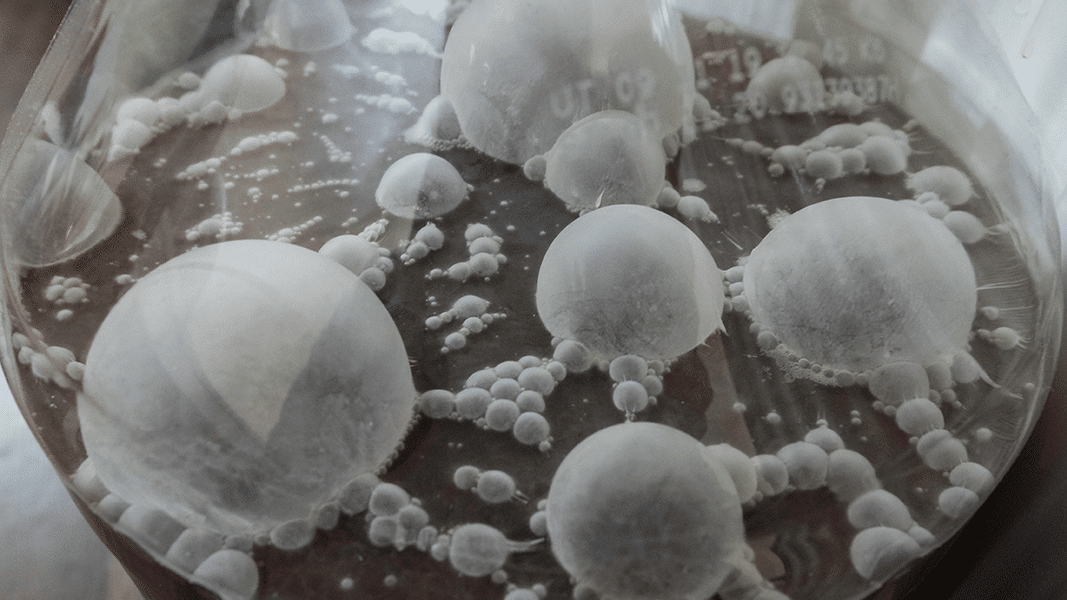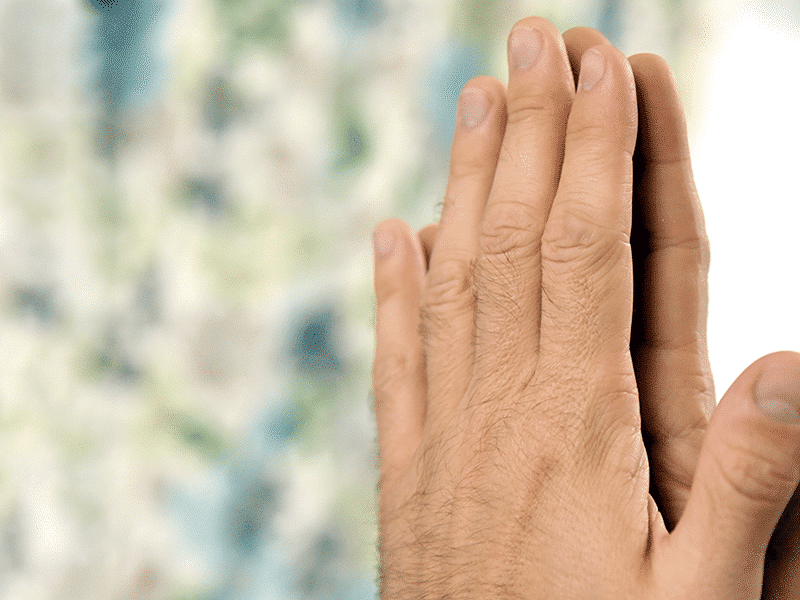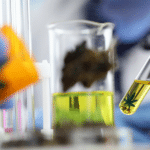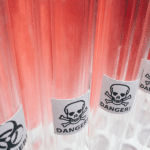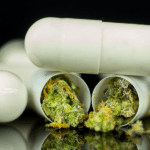In the not-too-distant future, the CBD or THC you consume when you swallow an infused edible or tincture may not be derived from cannabis at all. Your daily dose of cannabinoids might be grown in a laboratory instead of a greenhouse.
Kevin Chen, CEO and co-founder of Hyasynth Bio, describes the Montreal-based start-up as “focused on engineering strains of yeast to produce the active compounds of cannabis without having to grow plants.”
Hyasynth is one of several such firms with high hopes for “bio-synthesis” of cannabinoids. Since its founding in 2014, Hyasynth has raised $12 million in investment, the bulk of it coming from New Brunswick’s Organigram, one of Canada’s leading licensed producers of cannabis.
“We’re still in the research and development stage, but we hope to sell to companies bringing CBD to market,” Chen says. “We expect to see food and beverage companies get into this. There are several advantages to industrial fermentation, including efficiency gain, especially with larger scale production. It’s a lot faster and easier for a higher yield.”
He notes that lactic acid, ascorbic acid (vitamin C), and many antibiotics are already produced by this method.
Gene-Splicing Technology
Chen says that companies in the US, China, and elsewhere around the world are “synthesizing genes from individual nucleic acids, the sub-units of DNA.”
The technology was first pioneered in the 1970s by the San Francisco-based Genentech to produce insulin — which was previously extracted from pig pancreases, a very inefficient method by contemporary standards. Today, the process begins with gene-splicing — taking human DNA and placing it into a bacterium, from which the insulin can then be produced.
“Similarly, we’re putting a cannabis gene into yeast,” Chen explains. “In the mapping of the cannabis genome over the past 20 years, researchers have been identifying the genes responsible for producing cannabinoids. That research is publicly available, so we don’t have to actually handle cannabis ourselves. We are getting the genes for the enzymes that are responsible for its production, and we add it to the yeast genome. These genes are made synthetically and arrive in the mail as a small tube of clear liquid.”
For instance, CBDA synthase and THCA synthase are enzymes that stimulate production of CBDA and THCA, which are respectively the raw botanical precursors to CBD and THC. Lab-produced versions of these enzymes are already being added to yeast to grow CBDA and other cannabinoid acid molecules.
Chen emphasizes that “the CBD we produce is not different from that derived from plant extraction. We are using an engineered yeast to produce the stuff, but the end product is not modified.”
What is unique is the process. “We are developing our own patent portfolio and have made several submissions so far. Two of our applications are published,” Chen says. “We are developing a proprietary process for the production of cannabinoids. Our IP portfolio will include many different aspects of that process, including unique aspects of our yeast strains that we’ve developed.”
Yeast-Generated CBD
There is obvious market potential for yeast-generated CBD isolate in edibles, which are just now poised to take off in Canada. Edibles have been legal under Canada’s medical marijuana program since 2015 pursuant to a Supreme Court decision, and became legal for the adult-use market under Health Canada regulations that took effect in 2019. So while the industry in the United States is still waiting on the FDA to approve the use of CBD in edibles and health supplements, in Canada this sector is set for fast growth.
However, unlike in the US where unregulated CBD products are seemingly everywhere, CBD is only available at licensed cannabis dispensaries in Canada. And whereas CBD-rich edibles and THC-rich edibles have been available for several years through licensed storefronts in US states that have legalized cannabis, cannabis-infused edibles are just beginning to hit the market in federally legalized Canada.
“In every market we have to do an analysis,” says Chen. “More regulators are catching up with the technology. In Canada, all cannabinoids are treated the same under law no matter how they’re derived. We are actively analyzing whether it would be legal in US.”
Pursuant to Canada’s 2018 Cannabis Act, all cannabinoids are now regulated by the provinces with oversight from Health Canada’s Controlled Substances and Cannabis Branch, as opposed to the federal Office of Controlled Substances, which relinquished the oversight it had maintained under the Controlled Drugs and Substances Act.
As for the enzymes used to initiate cannabinoid production, Chen calls this a “baby step in the process” not restricted under either US or Canadian law. “The gene is not treated as a controlled substance,” he says.
Legal complexities notwithstanding, these yeast-derived CBD products could be marketed on both sides of the US-Canadian border in the near future.
Big Bud Looks Beyond Real Bud
Organigram’s 2018 $10 million investment with Hyasynth is one of several like deals recently reported, in both Canada and the US as well as Europe.
Also in 2018, Toronto’s giant licensed producer Cronos Group announced a strategic partnership with Boston-based Ginkgo Bioworks, which is also pursuing cannabinoid production through fermentation. The Canadian Press put the deal at $22 million. According to Cronos chief executive Michael Gorenstein, the partnership will focus on “rare cannabinoids,” which are “economically impractical” to produce at scale through “traditional cultivation and extraction.”
Among other companies pursuing this method are Vancouver-based InMed Pharmaceuticals and Amyris of Emeryville, CA, near Berkeley. Ginkgo Bioworks and Amyris both hold US patents on producing cannabinoids from yeast.
The proximity of the University of California’s most prestigious institution promises to make the East Bay a research hub in this sphere. TechCrunch reports that Demetrix, founded by UC Berkeley researcher Jay Keasling and led by former Amyris executive Jeff Ubersax, received an infusion of $50 million from Horizons Ventures, the Hong Kong firm backed by real estate billionaire Li Ka-shing, and Tuatara Capital, a Manhattan-based fund that invests in the legal cannabis industry.
At least one European company is also on track with this methodology. Last year Farmako of Frankfurt applied with the European Patent Office for worldwide rights to a micro-organism it has developed for the production of cannabinoids from sugar. The engineered bug, dubbed Zymomonas cannabinoidis, is a modified version of Zymomonas mobilis, the bacteria used to produce tequila. As Digital Journal notes, the genes responsible for production of alcohol were removed and replaced with genes from the cannabis plant — and the malaria parasite, of all things.
Skirting the Law
THC has already been synthesized and marketed for pharmaceutical use in the US. There are two brands on the market, Marinol and Syndros, which use a synthetic THC compound called dronabinol. It was approved by the FDA in 1985, primarily for treatment of the wasting syndrome in AIDS patients (by stimulating the appetite) and alleviating nausea caused by chemotherapy. A third FDA-approved drug, Cesamet, also prescribed for chemo patients, contains a synthetic THC analogue known as nabilone. But these pharmaceuticals are chemically synthesized, while the focus of the new research is on biosynthesis.
It’s a tantalizing prospect — producing new biological compounds that mimic the activity of cannabinoids actually found in cannabis but are nonetheless unique enough to be patented. This possibility holds particular promise for the industry’s future, according to Kevin Chen, who told Project CBD that Hyasynth has already produced “novel cannabinoids that aren’t found in the cannabis plant.”
Similarly, Jeff Chen (no relation to Kevin), executive director at the UCLA Cannabis Research Initiative, told Green Entrepreneur last year that “these novel compounds can be patented, and [scientists] are able to modify the molecules for different ailments.” And claims to patentable “novelty” will be far less ambiguous for biosynthetic compounds than attempts to patent specific cannabis cultivars.
Carly Bader, analyst for the microbial team at Denver-based AgriScience Labs, maintains that the legal restrictions pertaining to cannabis actually incentivize the creation of modified cannabinoids.
As Bader explained to Project CBD: “You could modify these chemicals in such a way that it doesn’t act in a different way, it has the same analgesic effect, for instance — but the molecule has an extra ring structure. The extra ring structure is inert, but this makes it not THC or not CBD. So it lets you skirt around the law, because there’s no genus cannabis involved.”
Purity Versus Efficacy
But Bader also notes that only the entourage of plant-derived cannabinoids provide the “full spectrum” effect. “You can isolate cannabinol (CBN), cannabigerol (CBG) or cannabichromene (CBC). But there’s this idea that these things work together, so purity may not be best when it comes to producing the effect you want.”
On the other hand, biosynthetic technology could address a critical need if demand grows for these and other rare compounds — the alphabet soup of minor cannabinoids — with hitherto unexplored therapeutic potential.
“The plant would never make a high enough concentration of these cannabinoids for their health benefits to be clinically relevant,” says Bader. “One of our clients is making a topical with 500 milligrams of CBN per gram. Now, they are using plant derived CBN, but it takes a lot of plants and a lot of effort to produce.”
CBN, she notes, is also in a legally ambiguous category. “It is not listed as a controlled substance but can be considered an analogue of THC,” Bader says.
“It is not always clear or precise whether a particular chemical structure is legal,” Bader elaborates. “After so many years of prohibition, we’re kind of working in the opposite way with cannabis — we’ve made this plant legal in certain states, and now have to determine what else is legal. When I was researching cholera toxin, nobody was withholding it from me. Whereas with cannabis, we’re moving from an atmosphere in which there was no federal funding, it was all illegal, to trying to strip these laws and allow the research to happen.”
“Whether it’s law or stigma, it’s an obstacle to getting into this field,” Bader acknowledges. “I had to take a big breath before I got involved because I knew it would place me on a certain spectrum. But now I’m proud to be involved and helping to advance science and public health.”
The Rise of Franken-Cannabinoids?
Such idealism, however, is not shared by everyone within the cannabis industry. A deep wariness toward biosynthetic technology persists among cannabis advocates who favor old-school botany over single-molecule substitutes.
Genetically modified organisms (GMOs) in crops and cuisine are often derided as dangerous “Frankenfoods.” Are we witnessing the advent of potentially dangerous and/or socially irresponsible “franken-cannabinoids” biosynthesized from yeast? Is fermentation the future of pharmaceutical CBD and cannabimimetic drugs?
A commentary on the website of the Thai Cannabis Corporation, dedicated to advancing the nascent cannabis industry in the Southeast Asian nation, expresses some forebodings about what lab-grown cannabinoids could mean for growers of the good old-fashioned plant, especially in the developing world.
The commentary draws an analogy to vanillin, the organic compound that gives vanilla its flavor. It is of course a key constituent of the vanilla plant. But today lab-synthesized vanillin supplies more than 99% of the global demand for vanilla flavoring. And that means less than 1% is supplied by extracts from farmed vanilla. Most of that 1% today comes from Madagascar, where growing vanilla is a rough life, as noted: “After Madagascar was recently hit by cyclones and drought, the cost of farmed vanilla extract shot up … yet Madagascar’s farmers remain poor.”
A Vanilla Future?
The Thai Cannabis Corporation foresees a similar future for cannabis: “Just as with vanillin, artificial THC, CBD, CBG, etc. are likely to be ‘good enough’ to satisfy 99% of global demand. All of the world’s cannabis farmers will be fighting over the remaining 1% of global demand, and only the world’s best cannabis farmers, in its poorest developing nations, will survive … if you call extreme poverty ‘surviving.’”
The commentary suggests that biosynthetic technology could eventually develop to the point where it could actually mimic the full-spectrum entourage effect: “Chemists are very likely to be able to blend artificial cannabinoids, terpenes, and flavonoids into an imitation extract that’s subjectively indistinguishable from, and as effective as, the extracts from the very best farmed Gorilla Glue, Jack Herer, Charlotte’s Web, or any other cannabis strain.”
Which could spell eventual disaster for cannabis growers.
But it’s by no means certain that the human hand will ever be able to replicate the natural, adaptogenic complexity of the plant. Or that artificial cannabinoids could ever satisfy the escalating worldwide demand for cannabis, a remarkably versatile plant that’s been an ally of humankind since before the written word.
Asked for thoughts on how biopharming might impact cannabis farming, Hyasynth’s Kevin Chen responds: “Cannabinoids have immense potential as pharmaceuticals, while vanilla does not. Scale and consistency are important when considering the pharmaceutical supply chain, which is partly why the insulin story is so successful … I think most people agree that cannabis is a unique scenario, and also that having access to high-quality and low-cost medicine is a good thing.”
It’s a truism that technology often proves to be a double-edged sword, evoking promise as well as peril. And that’s why we must keep a watchful eye on developments in corporate biotech labs from Montreal to Frankfurt and the East Bay.
Bill Weinberg, a Project CBD contributing writer, is a 30-year veteran journalist in the fields of drug policy, ecology and indigenous peoples. He is a former news editor at High Times magazine and produces the websites CounterVortex.org and Global Ganja Report. © Copyright, Project CBD. May not be reprinted without permission.
Recommended Readings
Special Report on Cannabinoids & Chirality
The promise and pitfalls of synthetically produced CBD.
Sequencing the Cannabis Genome
Medicinal Genomics has sequenced the entire genome of Cannabis sativa L. How will this impact research?
Under the Radar: Synthetic Cannabinoids & EVALI
The CDC’s diagnostic criteria for EVALI parallel the symptoms of synthetic cannabinoid use.

